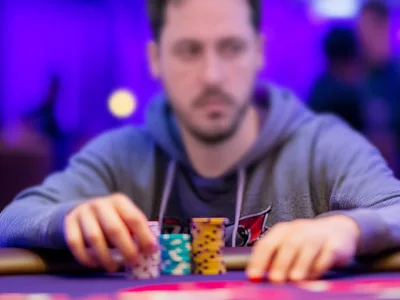Poker has changed dramatically over the last decade. Today’s top players train with solvers, internalize balanced strategies, and build decision trees designed to handle hundreds of possible outcomes. Yet even with perfect training tools, live poker still belongs to the players who know how to step outside of the theory when the moment demands it. Adrian Mateos’ fold with fewer than 500 players left in the 2024 World Series of Poker Main Event offers one of the clearest examples of why.
The hand began with a raise from the hijack. Sitting on the button with Kings, Mateos three-bet. The hijack responded by four-betting, setting up a clash between two of the deepest stacks remaining in the tournament. Mateos chose to simply flat the four-bet, feeling that 180 big blinds are too many to play for stacks at that stage of the tournament.
The flop came Q42 with two diamonds. The hijack continuation-bet for roughly one-third of the pot. In four-bet pots, solver-preferred sizing tends to be even smaller, closer to one-quarter of the pot. Mateos would later say that he immediately felt something wasn’t quite right, but obviously had no option but to call the flop.
The turn brought an offsuit Ten.
This time, the hijack bet approximately 60% of the pot, a sizeable second barrel. If Mateos called, the pot would be about five million chips, with only 2 million left in his stack. Mateos faced a critical decision: continue and face another tough spot on the river, or do the unthinkable and fold an overpair of kings on the driest of boards.
Solver outputs recommend a call at this point of the hand, with kings ranking near the very top of Mateos’ range and the board texture remaining largely favorable.
But something was telling Mateos this was not a spot for a standard call. He began filtering through the hands his opponent could realistically hold. Preflop dynamics made TT and QQ somewhat unlikely, as many players choose to call (or even fold) those to a 4-bet out of position. Ace-Queen could theoretically exist as well but often prefers flatting deep against a hijack open. Ace-King is the most natural bluff, but with two kings in Mateos’ hand, its frequency has to be greatly reduced as well.
Sizing provided Mateos with another important clue. Most players facing the pressure of the spotlight tend to simplify their games. Larger bets in four-bet pots, especially deep-stacked, often reflect strong value rather than balanced bluffing ranges. Few players, even among professionals, maintain perfect balance in these spots when the opportunity presents itself. So what hands were realistically left?
Going a step further, Mateos considered the live dynamics, noting that his opponent’s demeanor seemed strong. There were no signs of hesitation or second-guessing across two streets of betting.
Mateos reflected on the full picture: strong bet sizing, range construction tilted toward value, reduced bluff combinations, and live signals that reinforced an image of strength.
Knowing he was about to make either the blunder or fold of the year, Mateos did what many of us would consider impossible and slid his kings into the muck without seeing a river.
Soon afterwards, the broadcast stream confirmed what Mateos suspected: his opponent had pocket aces. Fold of the year, and perhaps in WSOP history, it was.
Mateos’ fold showed the truth about the human vs solver debate. While solvers can teach players how to structure their ranges, they cannot observe the realities at the tables. They cannot watch the breathing rhythms of an opponent. Nor can they account for the psychological weight of five days of tournament pressure.
The best players are able to absorb the outputs that solvers outline and then adapt them to the real world of live play. They recognize when frequencies collapse, when ranges tighten, and when patterns form that solvers will never see. They respect the theory, but they also know when to trust their own judgment and intuition.
When that moment comes, only a few players respond the way Mateos did. He didn’t let his doubt overwhelm him. He didn’t let the fear of looking foolish prevent him from making the play he felt was right.
He just folded his hand—and lived to fight another day. A fold that only someone who studied the theory, lived and breathed the game, and trusted himself more than a machine could make.

